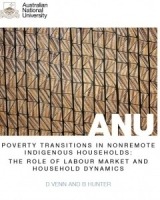Poverty transitions in nonremote indigenous households: the role of labour market and household dynamics

Abstract
Using data from the Household Income and Labour Dynamics in Australia (HILDA) Survey, this paper estimates year-to-year poverty entry and exit rates for Indigenous and non-Indigenous individuals living in nonremote areas of Australia. Indigenous Australians of working age have a higher probability of entering poverty and a lower probability of exiting poverty than non-Indigenous people. Changes in household size are the biggest triggers of poverty entry and exit for Indigenous people, accounting for almost 50% of poverty entries and 40% of poverty exits. Changes in household size are more prevalent for Indigenous than non-Indigenous people, due partly to higher birth and partnering rates, and to the greater proportion of Indigenous people who live in dynamic extended-family or multifamily households. Indigenous people who experience changes in household size have a greater likelihood of entering poverty and a smaller likelihood of exiting poverty than non-Indigenous people. The labour market plays a prominent role in triggering poverty transitions for Indigenous people. Among those in poverty, increased exposure to the labour market (either by having more household members working or higher labour earnings) results in a 62% likelihood of exiting poverty, while reductions in employment and labour earnings trigger around one-quarter of poverty entries for Indigenous people. Changes in private income, such as business and investment income, play a much smaller role in triggering poverty entries and exits for Indigenous than non-Indigenous people, largely because Indigenous people get far less of their income from such sources. The results suggest that Indigenous poverty is likely to be more persistent than non-Indigenous poverty, thus having a bigger negative impact on wellbeing. Greater exposure to the labour market and more access to other sources of private income are likely to reduce poverty incidence among the Indigenous population, but the dynamics of Indigenous households leave them at greater risk of persistent poverty, all other things being equal.
Keywords: Indigenous, poverty, employment, household dynamics







